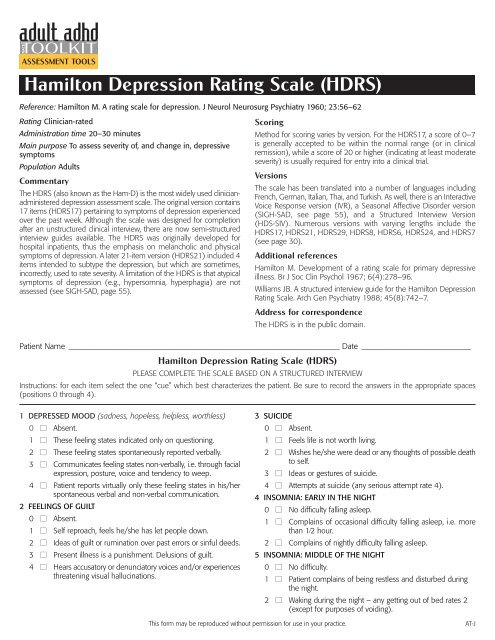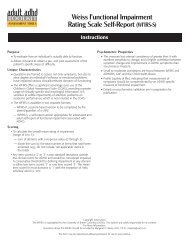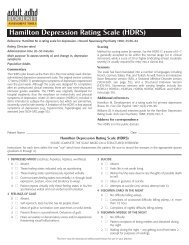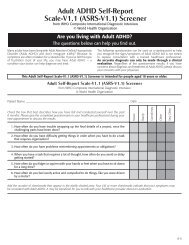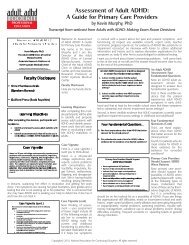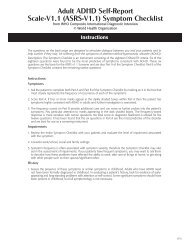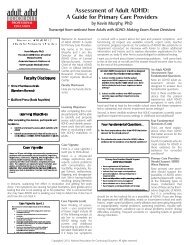A Resource for Clinicians - National Association for Continuing ...
A Resource for Clinicians - National Association for Continuing ...
A Resource for Clinicians - National Association for Continuing ...
Create successful ePaper yourself
Turn your PDF publications into a flip-book with our unique Google optimized e-Paper software.
ASSESSMENT TOOLSHamilton Depression Rating Scale (HDRS)Reference: Hamilton M. A rating scale <strong>for</strong> depression. J Neurol Neurosurg Psychiatry 1960; 23:56–62Rating Clinician-ratedAdministration time 20–30 minutesMain purpose To assess severity of, and change in, depressivesymptomsPopulation AdultsCommentaryThe HDRS (also known as the Ham-D) is the most widely used clinicianadministereddepression assessment scale. The original version contains17 items (HDRS17) pertaining to symptoms of depression experiencedover the past week. Although the scale was designed <strong>for</strong> completionafter an unstructured clinical interview, there are now semi-structuredinterview guides available. The HDRS was originally developed <strong>for</strong>hospital inpatients, thus the emphasis on melancholic and physicalsymptoms of depression. A later 21-item version (HDRS21) included 4items intended to subtype the depression, but which are sometimes,incorrectly, used to rate severity. A limitation of the HDRS is that atypicalsymptoms of depression (e.g., hypersomnia, hyperphagia) are notassessed (see SIGH-SAD, page 55).ScoringMethod <strong>for</strong> scoring varies by version. For the HDRS17, a score of 0–7is generally accepted to be within the normal range (or in clinicalremission), while a score of 20 or higher (indicating at least moderateseverity) is usually required <strong>for</strong> entry into a clinical trial.VersionsThe scale has been translated into a number of languages includingFrench, German, Italian, Thai, and Turkish. As well, there is an InteractiveVoice Response version (IVR), a Seasonal Affective Disorder version(SIGH-SAD, see page 55), and a Structured Interview Version(HDS-SIV). Numerous versions with varying lengths include theHDRS17, HDRS21, HDRS29, HDRS8, HDRS6, HDRS24, and HDRS7(see page 30).Additional referencesHamilton M. Development of a rating scale <strong>for</strong> primary depressiveillness. Br J Soc Clin Psychol 1967; 6(4):278–96.Williams JB. A structured interview guide <strong>for</strong> the Hamilton DepressionRating Scale. Arch Gen Psychiatry 1988; 45(8):742–7.Address <strong>for</strong> correspondenceThe HDRS is in the public domain.Patient Name ___________________________________________________________________ Date ___________________________Hamilton Depression Rating Scale (HDRS)PLEASE COMPLETE THE SCALE BASED ON A STRUCTURED INTERVIEWInstructions: <strong>for</strong> each item select the one “cue” which best characterizes the patient. Be sure to record the answers in the appropriate spaces(positions 0 through 4).1 DEPRESSED MOOD (sadness, hopeless, helpless, worthless)0 ■ Absent.1 ■ These feeling states indicated only on questioning.2 ■ These feeling states spontaneously reported verbally.3 ■ Communicates feeling states non-verbally, i.e. through facialexpression, posture, voice and tendency to weep.4 ■ Patient reports virtually only these feeling states in his/herspontaneous verbal and non-verbal communication.2 FEELINGS OF GUILT0 ■ Absent.1 ■ Self reproach, feels he/she has let people down.2 ■ Ideas of guilt or rumination over past errors or sinful deeds.3 ■ Present illness is a punishment. Delusions of guilt.4 ■ Hears accusatory or denunciatory voices and/or experiencesthreatening visual hallucinations.3 SUICIDE0 ■ Absent.1 ■ Feels life is not worth living.2 ■ Wishes he/she were dead or any thoughts of possible deathto self.3 ■ Ideas or gestures of suicide.4 ■ Attempts at suicide (any serious attempt rate 4).4 INSOMNIA: EARLY IN THE NIGHT0 ■ No difficulty falling asleep.1 ■ Complains of occasional difficulty falling asleep, i.e. morethan 1⁄2 hour.2 ■ Complains of nightly difficulty falling asleep.5 INSOMNIA: MIDDLE OF THE NIGHT0 ■ No difficulty.1 ■ Patient complains of being restless and disturbed duringthe night.2 ■ Waking during the night – any getting out of bed rates 2(except <strong>for</strong> purposes of voiding).This <strong>for</strong>m may be reproduced without permission <strong>for</strong> use in your practice.AT-J


